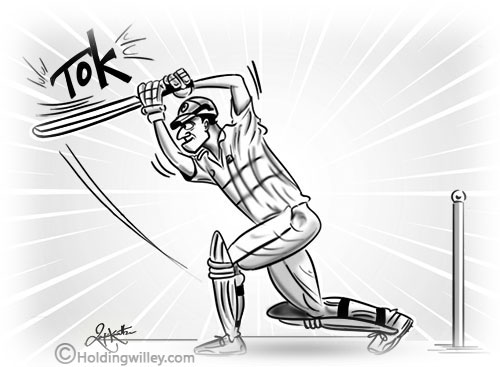 Twenty20 cricket, particularly the exceedingly popular Indian Premier League, has revolutionised batting beyond imagination. Adventurous, innovative shots are tried and often successfully and audaciously played to the delight of the audience.
Twenty20 cricket, particularly the exceedingly popular Indian Premier League, has revolutionised batting beyond imagination. Adventurous, innovative shots are tried and often successfully and audaciously played to the delight of the audience.
The Six, that most glamorous and productive hit, is now played by almost all batsmen as frequently as it was rarely attempted during the high-noon of Test cricket, when no-four-before-lunch was a credo held by the likes of Geoffrey Boycott, for instance, who believed in building the innings brick by brick.
Salim Durrani, that handsome left-hand all-rounder of the 1960s and early 1970s, was an attacking batsman, though he did not hit too many sixes during his career. But when he whacked about half-a-dozen sixes during the four Tests against England in 1972-73, he came to be known as Sixer Salim! Sixes were so rare those days.
“
Smashing sixes has become quite common now thanks to field restrictions and shortened boundaries. In fact, it does not come as a surprise when frontline batsmen go on the rampage and shower sixes into the stands because even the tail-enders go for the big shots.
”
And they too succeed, more often than not. Carlos Brathwaite, batting at No. 8, famously whacked four sixes in a row in the final over, snatching the World Twenty20 final from England’s jaws and became a hero overnight. The big Barbadian has many other hard-hitting tail-enders for company across the world.
Ironically, while sixes are smashed cleanly and spectacularly, fours are not executed as often and, barring a few, certainly not timed and placed well by many batsmen. This is particularly true of Twenty20 cricket. Hence the importance of batsmen like Ian Bell and Virat Kohli, who believe more in hitting fours than sixes. And for good measure they give the impression of scoring fours with effortless brilliance. Of course, both of them, particularly Kohli, are good at smashing sixes too, when the mood seizes them or the need arises.
It is still the fours played between two fielders and not the savagely struck sixes that send the cognoscenti among spectators and viewers into raptures. A class batsman like Kohli attracts more applause when he hits a four off the back foot against an express fast bowler than someone slogging a six off a spinner.
“
The charm of batting lies in playing a perfect cover-drive or a straight-drive, a square-cut or a flick off the toes, or any other shot – and there is a whole repertoire of cricketing shots – between two fielders, against a speedster or a spinner on top of his bowling. It brings out the whole genius of a master batsman and enthrals the connoisseurs. Cricket has always given pride of place to such wizards of the willow.
”
When Gundappa Viswanath played a rasping square-cut or a scintillating square-drive against Andy Roberts, Michael Holding or Dennis Lillee firing on all cylinders on a scorcher of a pitch with the ball speeding to the boundary in a split second without a fielder moving an inch from his position, it was hard even for the cricketing ignoramuses not to admire and fall in love with the shot and its executor.
When David Gower played an on-drive with his almost lazy elegance against Imran Khan or Richard Hadlee at their best, sending the ball racing to the ropes, it drew more cheers than when Ian Botham hit a six off Bishan Singh Bedi or Abdul Qadir. Kohli’s classic cover-drive, or flick, is bound to be liked more than the sixes regularly hit by someone like, say, Chris Gayle.
Why, even AB de Villiers is more delightful to watch when he lets loose a flurry of fours – square-cut, square-drive, cover-drive, straight-drive, on-drive, hook, pull, et al – to every corner of the field than when he hits those trademark sixes of his. Much the same could be said about many modern masters of the willow, including Joe Root and Steven Smith.
Cheteshwar Pujara may have been typecast as a Test specialist, but he is basically an attacking batsman and has an array of exciting shots at his command. When he bats in an aggressive mood after settling down, playing one sparkling shot after the other, Pujara is a sight to behold. Even with his flurry of fours he can hold a knowledgeable audience spellbound.
It is technically, even scientifically, proven that perfectly timed, placed and executed boundaries are more difficult than the commonly hit sixes, however lusty or powerful. Compared to today’s standard, Don Bradman, Denis Compton, Graeme Pollock, Sunil Gavaskar, Zaheer Abbas, Vivian Richards and Martin Crowe did not hit too many sixes, but the fours they struck were often both magnificent and majestic.
It goes without saying that sixes will continue to hold sway and entertain the masses, whether it is Tests, ODIs or Twenty20s. But as far as true lovers of technical excellence, including aesthetes, are concerned, sweetly timed and perfectly placed fours against hostile fast bowlers and beguiling spinners will always be more attractive – even in Twenty20 cricket.
Fast. Lite. Innovative. Shareable. Download our HW Cricket app!